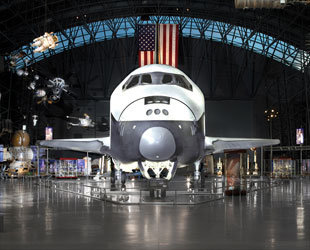December 16, 2010 — Plans are moving forward for the display of two of NASA's soon-to-be-retired space shuttles at the Smithsonian and the Kennedy Space Center.
Although NASA has yet to announce where its orbiters will be dispatched once they cease flying missions next year, recent actions have helped remove obstacles and clarify the logistics for the Washington, DC institution and Florida spaceport to receive shuttles.
In the case of the Smithsonian, it was long thought to be the future home of shuttle Discovery, NASA's oldest flying orbiter. Budget constraints called that plan into question.
As first reported by collectSPACE last month, NASA was not prepared to cover the estimated $28.8 million needed to prepare and transport the shuttle to the institution.
Now, Congress is passing legislation to make NASA do just that.
The Kennedy Space Center Visitor Complex wouldn't incur the costs to fly a shuttle to its facility — it would simply need to roll the orbiter down the road. But up until now, the tourist attraction has trailed many of the other 20 shuttle suitors releasing their display plan for an orbiter, assuming they were granted one.
On Wednesday, the visitor complex revealed its intentions to build a $100 million exhibit to showcase a shuttle.

Updated! Photo Gallery: How to display a retired orbiter
No or nominal cost
When NASA first said it was reserving Discovery for the Smithsonian in 2008, it made it clear that the custodian of the National Collection would still need to cover the then estimated $42 million to ready and deliver the shuttle.
The cost, which lowered to $28.8 million at the beginning of this year, was still said to be beyond the Smithsonian's reach, according to sources close to the National Air and Space Museum who spoke with collectSPACE.
The Smithsonian refused interview requests, but public documents showed that the air and space museum's total annual budget — including the National Mall building; its Chantilly, Virginia-based annex, the Steven F. Udvar-Hazy Center; and the Paul E. Garber Preservation, Restoration and Storage Facility located in Suitland, Maryland — was about equal to the $28.8 million required by NASA.
As a result, for the first time since the discussion began about where the orbiters would go, Discovery seemed like it might be up for grabs. That is, until Congress decided to get involved.
On the evening of Dec. 8, the House of Representatives narrowly passed a yearlong continuing resolution (CR) to fund the federal government. The bill included a budget for NASA and "an interesting shuttle provision," as described by Jeff Foust writing on his blog SpacePolitics.com.
"The CR devotes nearly a page to issues associated with the disposition of shuttle orbiters... in particular cutting a special deal for the Smithsonian," Foust reported.
The spending bill excuses the Smithsonian from bearing the costs for transportation and preparing a retired orbiter for display.
"Should the Administrator determine that the Smithsonian Institution is an appropriate venue for an orbiter, such orbiter shall be made available to the Smithsonian at no or nominal cost," the resolution reads.
The Senate has yet to take up its own version, but a draft of the omnibus appropriations bill released on Wednesday included the same language.

Space shuttle Enterprise, exhibited at the Smithsonian's Steven F. Udvar-Hazy Center, would be replaced by Discovery. (NASM) |
Assuming it passes with that provision intact, Discovery should be Smithsonian-bound.
If so, then the Smithsonian's plan is to replace prototype shuttle Enterprise, now on display in the McDonnell Space Hangar at the Udvar-Hazy Center, with the flown-in-space orbiter.
Master plan's marquee element
Should Kennedy Space Center Visitor Complex — located just outside the shuttle's processing, launch, and landing site — be granted an orbiter, it will need to cover at least $20.5 million for "display preparation," including setting up the crew cabin and installing structural shells and skins in place of the hazardous systems that will be removed at NASA's expense.
It is unclear what the transportation cost would be, but its likely to be considerably less than the $8.3 million to ferry a shuttle atop NASA's modified Boeing 747 shuttle carrier aircraft.
Unlike the Smithsonian though, which has a hangar ready, the Visitor Complex will need to build a facility to house the retired spacecraft. NASA requires that the vehicle be exhibited inside an environmentally-controlled, enclosed building to protect and preserve it for future generations.
To that end, the complex announced on Wednesday it has a new "master plan," including a marquee element: a $100 million, 64,000 square-foot "orbiter home," that will allow visitors to view a space shuttle "in flight, showing how the spacecraft worked in space and providing a unique vantage point for guests looking at this remarkable vehicle up-close."
The display will be complemented by interactive features reflecting major accomplishments of the shuttle program, including the Hubble Space Telescope and construction of the International Space Station.
An artist rendition of the planned exhibit depicts the orbiter supported at an angle, giving visitors a clear view into its payload bay from one side and its tiled-underbody from the other. The shuttle would be positioned to appear as if it was in orbit, set against a large Earth backdrop and with its robot arm extended to support an astronaut.
"We would be honored to showcase one of the space shuttle orbiters so we have begun designing a dynamic, interactive exhibit to tell the space shuttle story from our own unique perspective," said Bill Moore, chief operating officer of Visitor Complex in the release.
If Kennedy Space Center is chosen to display an orbiter, its expenses won't be covered by a congressional waiver or by NASA. The visitor complex plans to fund the exhibit through revenue generated by admission, food, and retail sales at no tax payer expense.
